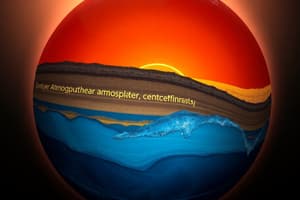Podcast
Questions and Answers
What is the definition of a closed system in the context of Earth?
What is the definition of a closed system in the context of Earth?
- A system that allows the exchange of both energy and matter.
- A system that is isolated from external forces.
- A system with an exchange of heat or energy but no exchange of matter. (correct)
- A system with no interactions between its parts.
Which layer of the atmosphere contains most of the water vapor and clouds?
Which layer of the atmosphere contains most of the water vapor and clouds?
- Stratosphere
- Exosphere
- Troposphere (correct)
- Mesosphere
At what altitude does the temperature typically decrease by 6°C per kilometer in the troposphere?
At what altitude does the temperature typically decrease by 6°C per kilometer in the troposphere?
- From 8 kilometers to 16 kilometers
- From sea level to 8 kilometers
- From sea level to 16 kilometers (correct)
- From ground level to the ozone layer
What is the primary gas composition of the Earth's atmosphere?
What is the primary gas composition of the Earth's atmosphere?
What process helps redistribute heat on the Earth's surface through the atmosphere?
What process helps redistribute heat on the Earth's surface through the atmosphere?
Which of the following statements about the atmosphere is incorrect?
Which of the following statements about the atmosphere is incorrect?
How does atmospheric pressure change with altitude?
How does atmospheric pressure change with altitude?
Which process describes the constant exchange of heat and moisture between the atmosphere and hydrosphere?
Which process describes the constant exchange of heat and moisture between the atmosphere and hydrosphere?
What phenomenon occurs in the ionosphere due to the interaction between solar radiation and atmospheric atoms?
What phenomenon occurs in the ionosphere due to the interaction between solar radiation and atmospheric atoms?
Which layer of the atmosphere experiences a temperature increase from about -50°C to 0°C?
Which layer of the atmosphere experiences a temperature increase from about -50°C to 0°C?
What is the primary driving mechanism behind plate tectonics?
What is the primary driving mechanism behind plate tectonics?
What is the approximate thickness of oceanic crust?
What is the approximate thickness of oceanic crust?
Which layer of the atmosphere contains very little air and can reach temperatures of about 2000°C?
Which layer of the atmosphere contains very little air and can reach temperatures of about 2000°C?
What separates the crust from the Earth's mantle?
What separates the crust from the Earth's mantle?
What is the dominant rock type in the uppermost mantle?
What is the dominant rock type in the uppermost mantle?
In what layer do meteoroids burn up upon entry to the Earth's atmosphere?
In what layer do meteoroids burn up upon entry to the Earth's atmosphere?
How does the temperature change from the bottom to the top of the mesosphere?
How does the temperature change from the bottom to the top of the mesosphere?
Which of the following layers is considered the outermost layer of the Earth?
Which of the following layers is considered the outermost layer of the Earth?
Flashcards are hidden until you start studying
Study Notes
Earth System Overview
- Earth functions as a dynamic system with interacting components: hydrosphere, atmosphere, biosphere, and geosphere.
- The Earth system is a closed system, exchanging only heat and energy while matter remains constant.
- A contrasting open system allows for both energy and matter exchange.
Atmosphere
- The atmosphere is a thin layer of gases surrounding the lithosphere, composed of 78% nitrogen, 21% oxygen, and trace gases such as argon.
- Atmospheric circulation redistributes heat on Earth's surface, while the hydrologic cycle facilitates moisture exchange between the atmosphere and hydrosphere.
- Air density decreases with increasing altitude, making it cooler and thinner in mountainous regions.
Layers of the Atmosphere
- Troposphere:
- Extends up to 16 km over the equator and 8 km over poles; contains 90% of the atmosphere's mass and all water vapor.
- Temperature decreases by 6°C for every kilometer increase in altitude.
- Stratosphere:
- Reaches up to 50 km; contains the ozone layer which absorbs UV radiation, increasing temperature from -50°C at the bottom to 0°C at the top.
- Mesosphere:
- Extends to about 80 km; temperature decreases from 0°C to -90°C, protecting Earth from meteoroids.
- Thermosphere:
- Extends to 500 km; contains sparse air that heats up to around 2000°C due to solar radiation.
- Ionosphere:
- Rich in ions formed by solar radiation; contributes to auroras and affects radio reception.
- Exosphere:
- Above 500 km, gradually transitions into interplanetary space filled with radiation and magnetic fields.
Lithosphere
- Comprises the Earth's crust, mantle, outer core (liquid), and inner core (solid metallic).
- Plate tectonics is a crucial process driven by Earth's internal heat and mantle convection.
Layers of the Earth
- Crust:
- Thin outer layer divided into two types: continental (average thickness of 35 km, up to 70 km in mountains, primarily granite) and oceanic (about 7 km thick, predominantly basalt).
- The boundary between the crust and the mantle is known as the Mohorovicic discontinuity (Moho), identified by Andrija Mohorovicic in 1909.
- Mantle:
- Accounts for over 82% of Earth's volume, extending nearly 2900 km deep; primarily composed of peridotite, rich in magnesium and iron.
Studying That Suits You
Use AI to generate personalized quizzes and flashcards to suit your learning preferences.




